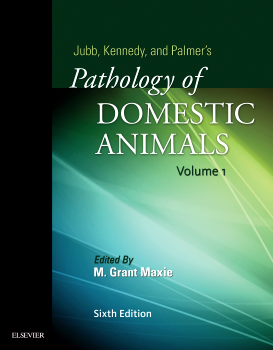Book Review: Jubb, Kennedy and Palmer's Pathology of Domestic Animals, 6th Edition
Elsevier’s 6th edition of Jubb, Kennedy and Palmer’s classic text Pathology of Domestic Animals has been published this year, eight years after the successful 5th edition, also edited by M. Grant Maxie. Once again the list of contributors is an impressive collection of experienced and well regarded veterinary pathologists active in practice and research in their respective fields.
As with the previous editions, this latest edition is divided across 3 volumes and now also features online content unlockable with a code provided with the hard or eBook versions of the text. The preface is written by the editor, M. Grant Maxie, and highlights the new features in the 6th edition, which are discussed in this review. For ease of use, the complete table of contents and index is included in every volume, together with the systems contained in each volume on the books’ spine. The general format is the same as previous editions; the book is divided into body system chapters, and subdivided into sections e.g. normal structure and development, patterns of pathology, and categories of disease (listed at the beginning of each chapter). A new chapter has been added to the beginning of the book, discussing the diagnostic process, featuring useful information for veterinary practitioners, students and pathology residents preparing for professional qualifications or wishing to understand the practice of diagnostic veterinary pathology.
An excellent addition to the 6th edition is colour images (gross and histopathology) which previous editions desperately lacked. All images are available at the accompanying website, in addition to an extra 325 images not found in the book – an invaluable resource for study and teaching. Also available on the website are details for further reading, expanding those found in the text, with direct links to the abstracts on PubMed where appropriate.
The contributors have comprehensively updated this edition to include the vast number of developments in the field, including updated understanding of pathogenesis, molecular pathology, new figures and current terminology. The text is presented in an easy to read format, with appropriate figures referenced in the body of the text and further reading at the end of each section. Tables, boxes containing key points, and subheadings assist the reader searching for specific information, and are also great for those studying who want to consolidate the vast amount of information. The editing has resulted in a pragmatic text which is logically presented and a joy to read making it very approachable for both undergraduate and postgraduate students, as well as practicing pathologists.
The 6th edition continues the legacy of previous editions as a core text in veterinary pathology, unifying new literature and providing an excellent resource for students and practitioners alike. It is also an essential set of books for any trainee in veterinary pathology, and whose breadth and depth remains unrivalled by any other veterinary pathology textbook of domestic animals.
| This book was reviewed by: Date reviewed: November 2015 |
